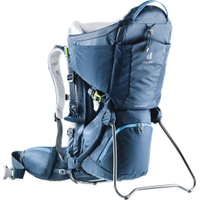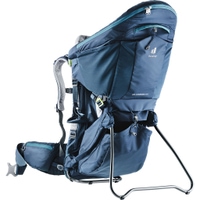Your child is not yet old enough for hiking and to hike with a buggy is too complicated? With a child carrier, you can easily solve this problem and take your little darling on adventures in nature. Hikes, smaller mountain tours but also long walks on uneven ground can easily be mastered. It is important, however, that the child can already sit autonomously – between one to three years a child carrier, therefore, is an ideal companion.
kid carriers: that’s important
A backpack should be as comfortable as possible – for both the carrier and the carried child. Here are a few things that you should consider when buying a kid carrier:
Carrier system
A kid carrier – including the child, water, and whatever else is needed – can be quite heavy. Up to 15 till 20kg. A high-quality and comfortable carrying system is therefore particularly important. Sturdy shoulder, hip, and chest straps and good padding are crucial. In addition, the carrying system should be height adjustable, so that it can be carried by different people. Between the parents, there might be a considerable size difference. To make it comfortable to wear for everyone, it must, therefore, be quickly and easily adjustable to the carrier’s back length.
Storage and hydration system
In addition to a good carrying system, it is an advantage if the carrier offers enough storage space to be able to take necessary things such as extra clothes, snacks, and also the kid’s favorite cuddly toy with you. Of course, you should not pack too much either, as every additional gram on the back quickly becomes quite heavy. In addition, an integrated hydration system is particularly practical, as you do not have to get your bottle out of the backpack which might even require you to put down the carrier.
Seat, belt, and footrests
In order for the kid to sit comfortably and safely in the carrier, there are a few important features. First of all, the seat needs good padding and also a chin pad is important in case the child falls asleep and the head sinks forward. In addition, the seat should be height adjustable so that it can be adjusted according to the size of the kid. Only then you can use the backpack for several years and can carry different children. To prevent the child from falling out of the kid carrier, for example, if you bend forward or trip, a secure belt is essential. Especially 4- or 5-point belt systems are recommended. Another important detail is the height-adjustable footrests. They prevent the child’s legs from falling asleep and keep the legs in a stable position.
Sun and rain protection
To prevent the kid from being exposed to the blazing sun or the rain, additional sunroofs and rain covers for kid carriers are available. As the weather in the mountains often changes quickly, these two extras should always be packed. On particularly hot and cloudless days, it is still advisable to choose alternative routes through the forest, because it can become quite hot also under the sunroof.
Stable foot
Last but not least, it is important that the kid carrier has a stable foot holding it on the floor and preventing it to tip over. This makes it a lot easier to put the kid in and out of the backpack. In addition, it allows you to put the carrier on the ground when taking a short break or needing something from the backpack. However, you should never leave the carrier unattended – a fidgeting child can still cause it to tip over.
Discover high-quality kid carriers and accessories from Deuter:
Are you interested in other related articles about hiking? We have some more for you:
→ Tips and Tricks for hiking with kids
→ Choosing the right mountain boot: all you need to know
→ Hike with the Right: Essentials you need for your next Hike and Trekking Tour
Photo Header: Deuter






